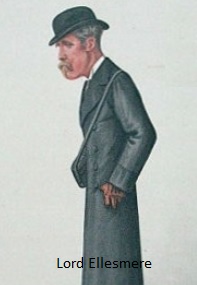
1891-1914 3rd Earl of Ellesmere
Francis Charles Granville Egerton, born on 5th April 1847, was the eldest son of George Egerton, 2nd Earl of Ellesmere, and Lady Mary Louisa. He was educated at Eton and Trinity College, Cambridge, gaining a BA in 1867, and was only 15 when his father died on 18th September 1862, making him the 3rd Earl of Ellesmere. Up to that point in time he liked to be known as Viscount Brackley. In 1864 he joined the Duke of Lancaster's Own Yeomanry, while on 5th December 1868 he married Lady Katherine Louisa Phipps, second daughter of the 2nd Marquess of Normandy, the marriage produced 11 children, of which 5 were sons, the eldest being John Francis Granville Scrope Egerton. The 3rd Earl enjoyed horse racing, owning many horses, including Hampton in its later racing days. In Autumn 1877 Lord Ellesmere purchased Hampton who, by then, had won the Great Metropolitan Stakes in 1875, in 1877 the Northumberland Plate, Goodwood Cup, Doncaster Cup, Kelso Gold Cup, Caledonian Centenary Cup and Queen's Prize, after which Lord Ellesmere took ownership. In 1878 Hampton won the Epsom Gold Cup prior to embarking on a hugely lucrative stud career. Lord Ellesmere sent Hampton off to his stud at Stetchworth Park, and such was the fortune Hampton generated at stud that Lord Ellesmere was able to develop Egerton Stud, on the outskirts of Newmarket, converting it into the most modern training establishment in the country. The original Stetchworth House was built in 1786 by Richard Eaton with a fortune his father, Richard Jefferson Eaton, had made from banking, the House replacing Stetchworth Manor House built centuries before.
For over 4 centuries racing has been staged in Newmarket, but how have the racecourses evolved from an initial starting point at Fleam Dyke Pumping Station, some 8 miles from the town, with a winning post barely 200 metres from the town centre, into two world recognized, excellent racecourses and a universal acceptance that Newmarket is the Headquarters of racing?
To access an interactive racecourse map showing over 50 individually named racecourses CLICK HERE. The map will enable you to:-
1. Determine when extended races over 8 miles, 6 miles and 4 miles began to be replaced by the courses now visited by thousands annually;
2. Consider how the challenge of crossing the Devil's Dyke was overcome;
3. Contemplate why the town no longer has a steeplechase course despite having at least 5 courses during the past 2 centuries;
4. Examine the practicalities of having up to 48 starting posts and winning posts;
5. Appreciate that it was not financially viable to have an open racecourse spread widely across the heath, with a finishing post barely 200 metres from the town centre;
6. Research how and why the Cambridgeshire Handicap has been contested over 3 different courses.
NOTE: The map does not make mention of 2 particular courses:-
(i) Sefton Course (also known as the Cambridge Road Course)
Source: 1970 Raceform. Used from 1959 to 1975.
(ii) New Circular Course
The Circular Handicap was run on Friday 29th October 1875 on the New Circular Course of about two miles.
Source: London Standard (30th October 1875): ''the horses started near the Turn of the Lands, ran back way of the Cambridgeshire Course towards the Ditch, and afterwards proceeded down the side of the Tan Gallop, and turned into the Rowley Mile near the Bretby Stakes starting post, finishing at the stand at the end of the flat. Except in the hollow near the Cambridgeshire start the runners should have been visible all the way if the sky had been bright and clear''.
Another report hoped that the Circular Handicap would become a feature in future programmes, as it would be contested in front of the new grandstand which would be completed in about a year and would be able to accommodate thousands.
(I am grateful to Tim Cox for bringing attention to these 2 courses.)
Enjoy researching the intriguing history of Newmarket and its many racecourses.
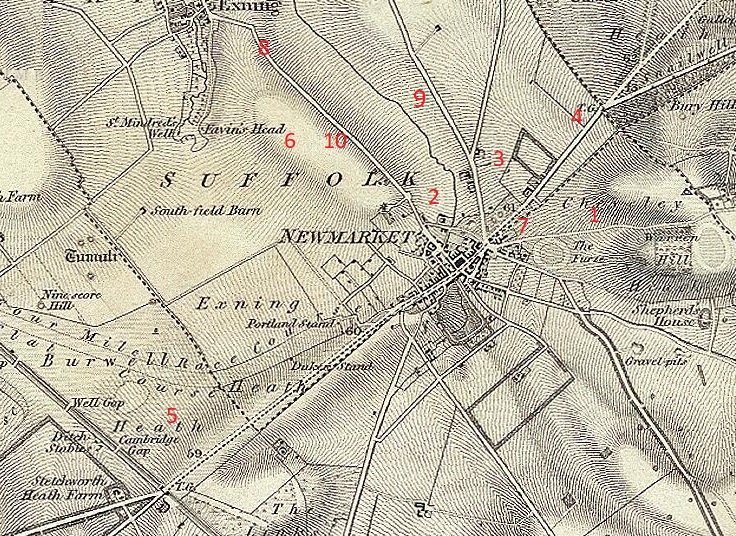
1892-1924 Richard Marsh
Richard John Marsh, born at Smeeth, Kent on 31st December 1851, was the son of a Kent farmer. Although his father had no links with the world of racing, Richard began riding racehorses in his teens, riding his first winner in 1866, while in 1869 he partnered Temple to victory in the New Stakes at Ascot. He retired from race riding in 1881, well after he had begun to train, using Banstead Manor, Epsom as his first training base in 1874. In 1876 he married Olive Thirlwell and they had a son, Charles, who later trained Cherimoya (SR 1890) to win the 1911 Epsom Oaks, and also in 1876 they moved to Six Mile Bottom, and afterwards to Lordship Farm, Newmarket to train for the Duke of Hamilton. In 1883 he trained his first English Classic winner when the Duke of Hamilton's Ossian (SR 1935) won the St Leger in the hands of John Watts.




1894 Ascot Gold Cup LA FLECHE 2/5 fav owned by Maurice de Hirsch, trained by Richard Marsh and ridden by John Watts
1894 Champion Stakes LA FLECHE 1/3 fav owned by Maurice de Hirsch, trained by Richard Marsh and ridden by John Watts
1895 Goodwood Cup FLORIZEL II (9/100 fav), owned by HRH Prince of Wales, trained by Richard Marsh and ridden by John Watts
1895 Ascot Gold Vase FLORIZEL II 5/6 fav owned by HRH Prince of Wales, trained by Richard Marsh and ridden by John Watts
1896 1000 Guineas THAIS (SR 1909) 5/1 owned by the Prince of Wales, trained by Richard Marsh and ridden by John Watts
1896 Epsom Derby PERSIMMON (SR 2078) 5/1 owned by HRH Prince of Wales, trained by Richard Marsh and ridden by John Watts
1896 St Leger PERSIMMON (SR 2078) 2/11 fav owned by HRH Prince of Wales, trained by Richard Marsh and ridden by John Watts
1897 Middle Park Stakes DIEUDONNE owned by 8th Duke of Devonshire, trained by Richard Marsh and ridden by Otto Madden
1898 Craven Stakes JEDDAH owned by James Larnach, trained by Richard Marsh and ridden by Otto Madden
1898 Epsom Derby JEDDAH (SR 1980) 100/1 owned by James Larnach, trained by Richard Marsh and ridden by Otto Madden
1898 Prince of Wales’s Stakes JEDDAH 7/4 owned by James Larnach, trained by Richard Marsh and ridden by John Watts
1899 Champion Stakes DIEUDONNE 7/1 owned by 8th Duke of Devonshire, trained by Richard Marsh and ridden by Morny Cannon
1900 2000 Guineas DIAMOND JUBILEE (SR 2032) 11/4 owned by HRH Prince of Wales, trained by Richard Marsh and ridden by Herbert Jones
1900 Epsom Derby DIAMOND JUBILEE (SR 2032) 6/4 fav owned by HRH Prince of Wales, trained by Richard Marsh and ridden by Herbert Jones

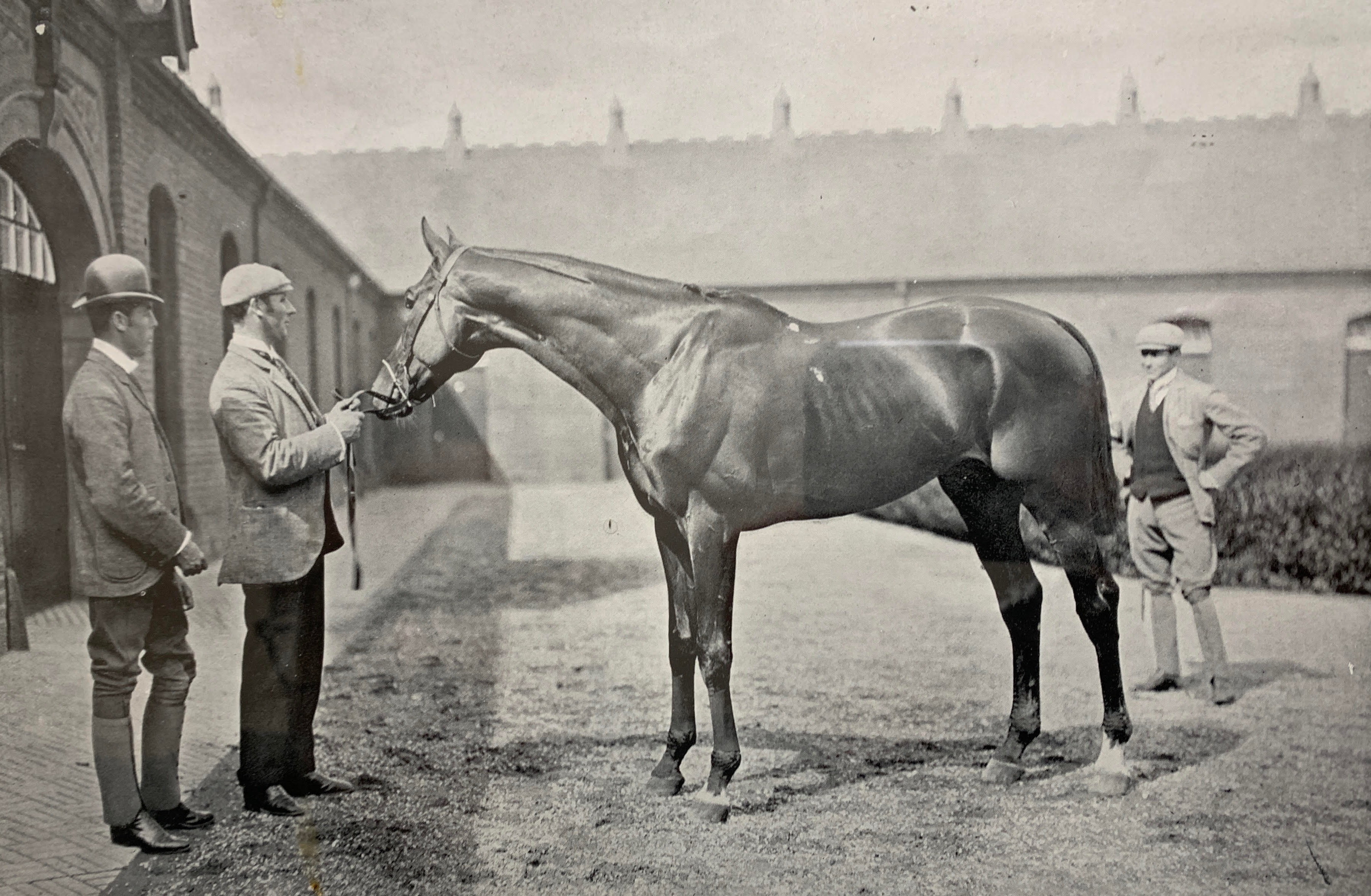
1901 Goodwood Cup FORTUNATUS 4/6 fav owned by Arthur James, trained by Richard Marsh and ridden by Danny Maher
1901 Champion Stakes OSBOCH owned by 4th Baron Wolverton, trained by Richard Marsh and ridden by Danny Maher
1902 Goodwood Cup PERSEUS Evens fav owned by Arthur James, trained by Richard Marsh and ridden by Joe Childs
1903 Goodwood Cup RABELAIS 5/4 fav owned by Arthur James, trained by Richard Marsh and ridden by John Watts
1909 2000 Guineas MINORU (SR 2016) 4/1 owned by HM King Edward VII, trained by Richard Marsh and ridden by Herbert Jones
1909 Epsom Derby MINORU (SR 2016) 7/2 owned by HM King Edward VII, trained by Richard Marsh and ridden by Herbert Jones
1914 Middle Park Stakes FRIAR MARCUS owned by King George V, trained by Richard Marsh and ridden by Herbert Jones
1923 Royal Hunt Cup WEATHERVANE 20/1 owned by HM The King, trained by Richard Marsh and ridden by Staff Ingham



William Jarvis, born in 1885, son-in-law of trainer James Ryan, was in charge of Green Lodge stables some years before James officially retired in 1910, but he then moved to Waterwitch House to continue his training career. When the First World War broke out William undertook his army service, but he then returned to training at Hackness Villa Stables in 1921, leasing them from Martin Gurry. In November 1923 he was recommended by George Lambton to train for the King George V at Egerton House, taking out a lease from Lord Harewood and moving there in readiness for the start of the 1924 season, replacing Richard Marsh. In 1925, the estate was sold to Henry Lascelles, the 6th Earl of Harewood, who was married to Princess Mary, daughter of King George V. In the first few years when William Jarvis took over at Egerton House Stables he trained exclusively for Lord Harewood and King George V, where in 1928 he recorded a Royal success in the 1000 Guineas when Scuttle (SR 1935) was victorious. In all William trained three Classic winners and married Isabel, the daughter of jockey Joseph Butters.
The pre-World War II cigarette card below, issued by E & W Anstie, shows the 'lads quarters' at Egerton House
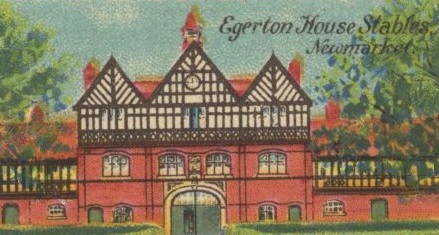
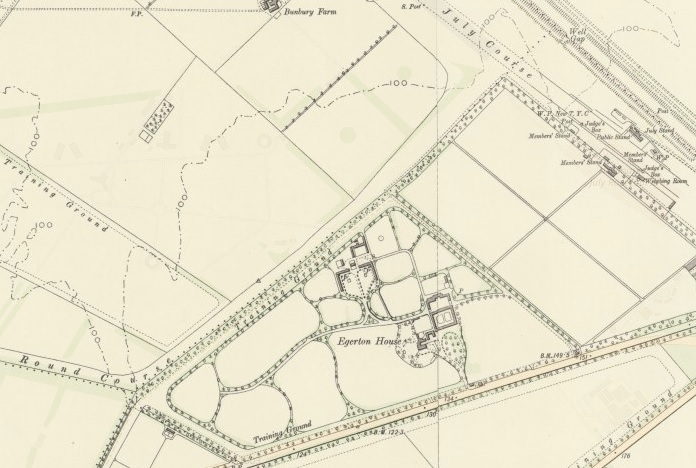
Their son Ryan was named in memory of the son of Rosa and Jimmy Ryan who had died aged just 19 in the typhoid epidemic which swept Newmarket in 1895. They also had a daughter Bridget, who married jockey Bill Rickaby. One of William's biggest successes whilst at Egerton House was during the War years when Godiva (SR 2047) won the New 1000 Guineas and New Oaks in 1940. William was supported in his later years by son Ryan, prior to Ryan training on his own account at Malborough House from 1937 until he was called up into the Grenadier Guards during the Second World War. Although Ryan probably had ambitions to train at Egerton, they were thwarted twice, firstly the 6th Earl of Harewood sold Egerton House Stud to Lady Catherine Macdonald-Buchanan in 1943, and secondly William Jarvis died in 1943, although Isabel continued to live at Egerton House until after the War had ended in 1945.
1928 1000 Guineas SCUTTLE (SR 1935) 15/8 owned by King George V, trained by William Rose Jarvis and ridden by Joe Childs
1940 New 1000 Guineas GODIVA (SR 2047) 10/1 owned by Esmond Harmsworth, trained by William Rose Jarvis and ridden by Doug Marks
1940 New Oaks GODIVA (SR 2047) 7/4 owned by Esmond Harmsworth, trained by William Rose Jarvis and ridden by Doug Marks
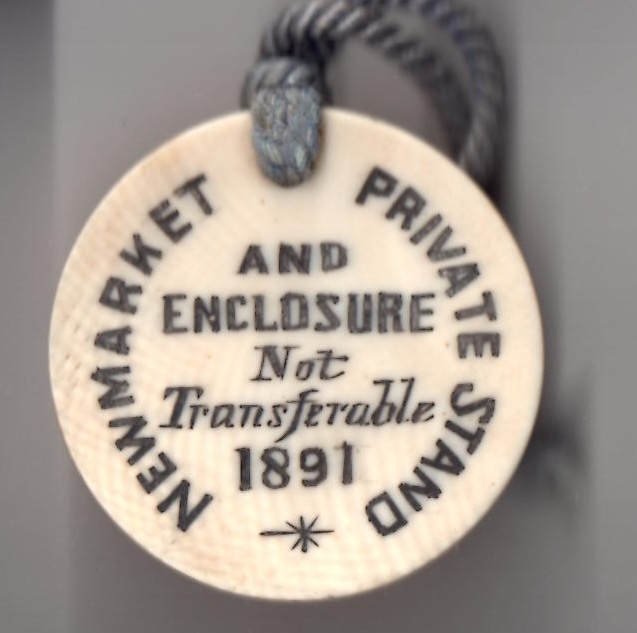
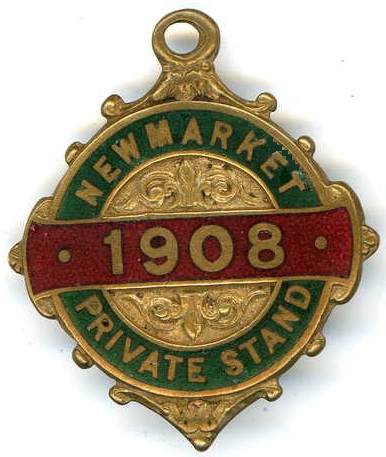

The Second World War Years
In January 1940 an inquest was opened on the death of Barbara Ellen Claydon, aged 16, of Egerton Stud, who was killed in a car accident on the Cambridge Road, Stetchworth, near the old tollbar, on 2nd December 1939, the car being driven by Louis Gilbert Drake, aged 30. The deceased's father, David Claydon, worked at Egerton Stud, and his wife, Mrs Edith Claydon, stated that her daughter worked in Cambridge and met up with her and Gunner Leonard Hayes Hawkins, who had been playing football, for tea at Lakeman's Cafe before Edith caught the 6pm bus home. Barbara and Leonard left some time later, making their way back to Egerton, walking together on the left side of London Road, when she was hit by a car and was left unconscious. She was taken to the Rous Memorial Hospital at 8pm, but early on the morning of 4th December she died from a brain haemorrhage.
In happier times for the Claydon family, Miss Edith Ruth Claydon, of Egerton Stud, married Ernest Albert Day at All Saints Church, Newmarket on Saturday 11th May 1940. She was given away by her father, David Claydon, while her only surviving sister, Phyllis, was the only bridesmaid.
In August 1940 it was announced that the best 3-year-old filly in training, the 1940 New Oaks and New 1000 Guineas winner Godiva (SR 2047), trained at Egerton House by William Jarvis, died at Lord Adare's Fort Union Stud in County Limerick, Ireland from blood poisoning.
After negotiations with Lord Harwood throughout 1942, Egerton House was purchased by the Macdonald-Buchanan's in August 1943.
The photo of Egerton House, shown opposite, was taken by an American serviceman, Captain Billy Emmett Vinson, who attended a wedding at Egerton House paid for by an American Colonel, when the wedding cake was made by German Prisoners of War, who also served dinner at the wedding.
Although Mrs Jarvis lived at Egerton throughout the duration of the Second World War, even after her husband had died and the House and Stud were sold to the MacDonald Buchanan's. The Americans occupied the place in the early part of the War, while British Army personnel were there even at the end of the war. Nearby Sefton Lodge and Falmouth Cottage were firstly used by aircrew officers, and later by WAAF up to April 1944, although it was more often that houses were requisitioned rather than stables. One casualty of the War was the gallop laid down by Mat Dawson in 1885 which was ploughed up in January 1941, as were many areas in the neighbourhood, to increase food production.
1947-1964 Lady Catherine Macdonald Buchanan, Marcus Marsh (until November 1949)
Egerton House was initially occupied by the Army in the early War years, although the Americans then moved in. After William Jarvis died in 1943, Isabel continued to dwell there, but at the end of the War the new owner of Egerton Stud, Lady Catherine Macdonald-Buchanan, appointed Marcus Marsh to train at Egerton House, although by then the King had transferred his horses to the care of Cecil Boyd-Rochfort at Freemason Lodge Stables. At that time Lady Macdonald-Buchanan's horses were trained by Fred Darling, Marcus's uncle, and it was an arrangement she hoped to continue. Marcus, in turn, brought a string of 30 horses and continued to retain Charlie Smirke as his first jockey. Catherine Macdonald-Buchanan, born in 1895, was the daughter of James Buchanan, 1st Baron Woolavington and Anne Pounder. He made his money through the Scottish whisky industry and Catherine inherited a fortune. She married Major Sir Reginald Narcissus Macdonald-Buchanan on 18th January 1922 and they had 2 sons, John, born on 15th March 1925, and Alexander, and a daughter Mary Cynthia. In 1935 she inherited Lavington Stud, while in 1942 she purchased Egerton Stud which, at one time had stood the King's Anmer until exported to Canada. The Aga Khan's 1935 and 1936 Derby winners Bahram (SR 2110) and Mahmoud (SR 2020) had also stood at Egerton Stud before their transfer to USA in 1940. At her Lavington Stud Lady Catherine had bred Owen Tudor (SR 2111), winner of the War time 1941 Derby. Marcus Maskell Marsh, son of Classic winning trainer Richard Marsh and Grace Darling, was born in 1904 and began training in the 1920s, although he did have to take a career break during the War when he served in the RAF. He trained 1934 Epsom Derby and St Leger winner Windsor Lad (SR 2100), while on 28th September 1936 he married Eileen Bennett, a tennis player. The couple moved to Egerton House Stables after the War, appointed by Catherine Macdonald Buchanan, and enjoyed the company and skills of Marcus Marsh until late 1949. In November 1949 the Aga Khan, who already leased Egerton Stud from Catherine, brought to an end his 18-year association with Frank Butters who, aged 71 was struggling to overcome an operation performed at a London Clinic on an injury from a cycling accident. Instead, the Aga Khan moved his horses to Fitzroy House Stables where Marcus Marsh had moved to, enjoying immediate success with Palestine in the 1950 2000 Guineas, and Tulyar in 1952, winning both the Epsom Derby and St Leger. Marcus retired from training in 1964 and died in 1983. The Lady Macdonald Buchanan continued to reside at Egerton House.
1964-1987 Lady Catherine Macdonald Buchanan
Lady Catherine Macdonald Buchanan continued to own Egerton Stud as well as Lavington Stud. Her eldest son, John, resided at Cottesbrooke Hall in Northamptonshire, managing Lavington Stud. Many famous stallions stood at Egerton Stud, none more so than Brigadier Gerard in 1972. He won 17 of his 18 races before suffering a defeat by Roberto in the Benson & Hedges Trophy race at York, and was then retired to stud at Egerton. He was not the success his owner, John Hislop, had hoped for and was eventually transferred to his owner's stud at East Woodhay. However, he did produce the 1980 St Leger winner Light Cavalry (SR 1932) and the 1981 Champion Stakes winner Vayrann. Lady Catherine later resided at Cottesbrooke Hall and died there on 12th February 1987.
August 2003-2005 David Loder
David Loder, son of Captain Simon Loder and Kathleen (nee Fleming) was born in Stow-on-the Wold, Gloucestershire on 27th January 1964 and began his working life in the City of London trading stocks and shares. However, the racecourse beckoned and he became assistant to two of the best mentors in the racing game, Sir Mark Prescott and Geoff Wragg. In 1992 he thought the time was right for him to launch his own training career, taking over at Sefton Lodge. He had a remarkably successful 4 years at Sefton Lodge, winning a Listed race with Lupescu at 20/1 within 4 weeks of the launch of his career, and went on to saddle 35 Group winners during his time at the Lodge. His top horses during this period were Desert Prince, Bahamian Bounty, Blue Duster, Embassy and Peter Davies who he sent to Chicago, after wins at Epsom and Sandown, to contest the Arlington Million, eventually finishing 5th behind Star of Cozzene. On the back of such success he was offered a contract to train for Godolphin, which he gladly accepted, reaching the pinnacle of his career when Desert Prince won the 1998 Irish 2000 Guineas. David was most famously in charge of a 2-year-old colt called Yaazer when he won a Yarmouth maiden in October 1998, suggesting to Sheikh Mohammed that the colt was the best of 60 young horses in the yard. This led to the Sheikh renaming the colt Dubai Millennium. The colt overwintered in Dubai with Saeed bin Suroor, returning to the Godolphin stables for his 3-year-old career, winning the 1999 Predominate Stakes at Goodwood and was made a strong favourite for the 1999 Epsom Derby. However, he ran badly and was beaten 9 lengths in 9th place behind Oath (SR 1937). He recovered his form to win the 1999 Queen Elizabeth II Stakes, while as a 4-year-old he won the Prince of Wales's Stakes and Dubai World Cup. David later moved to Egerton House Stables in late 2003 to continue his career, before being hit by a virus which forced him to take a step back from training in 2005.
April 2006-present David Elsworth
David Raymond Cecil Elsworth, born in 1939, prepared the path for his training career by assisting Lieutenant Colonel Guy Richardson 'Ricky' Vallance at his Bishops Canning Stables near Devizes in Wiltshire. He was keen to become a trainer in his own right, although the Jockey Club delayed his application when they enquired into the progress made by a horse called Well Briefed. He was eventually granted his licence in 1978 and continued to demonstrate his skill of training horses for over 4 decades. He began training at Whitsbury Manor Stables, near Fordingbridge, and almost immediately hit the headlines with the grey Desert Orchid. Dessie became the nation's favourite, winning 34 of his 70 races, including the King George VI Chase 4 times, in 1986, 1988, 1989 and 1990, as well as the 1990 Irish Grand National. David also guided Rhyme 'n' Reason to victory in the 1988 Grand National, the same year he was crowned Champion National Hunt Trainer, and won the 1990 Queen Mother Champion Chase with Barnbrook Again. Persian Punch was another of his stars, winning many of the leading stayers races, including the Doncaster Cup, the Goodwood Cup on 2 occasions and the Jockey Club Cup three times, but whilst many associate David with National Hunt racing, he also captured the 1990 Irish 1000 Guineas with In the Groove (SR 1897). She went on to win the 1990 Juddmonte International Stakes at York and the Champion Stakes, and stayed in training in 1991 to land the Coronation Cup. At the age of 67, when many of a similar age might wish to retire, David made the bold move to Egerton House Stables in April 2006, taking with him a 27-year-old grey, Desert Orchid. Unfortunately, Desert Orchid died on 13th November 2006, but by then he had forged a partnership with David Elsworth which would provide both with a permanent place in racing history. David continued his winning ways at Egerton, landing the 2006 Hampton Court Stakes at Royal Ascot with the Jeff Smith owned Snoqualmie Boy, a 50/1 surprise winner to most. Barshiba proved to be another money-spinner for Jeff when she won the 2007 Sandringham Handicap at Royal Ascot, going on to secure back to back wins in the 2009 and 2010 Lancashire Oaks at Haydock Park. More recently, Arabian Queen won the 2014 Duchess of Cambridge Stakes, the 2015 Princess Elizabeth Stakes and then gained an unexpected 50/1 victory over Derby winner Golden Horn in the 2015 Juddmonte International Stakes at York.
2006 Hampton Court Stakes at Royal Ascot SNOQUALMIE BOY 33/1 owned by Jeff Smith, trained by David Elsworth and ridden by John Egan
2007 Sandringham Handicap at Royal Ascot BARSHIBA 16/1 owned by Jeff Smith, trained by David Elsworth and ridden by Richard Quinn
2008 Lanwades Stud Severals Stakes BARSHIBA 11/1 owned by Jeff Smith, trained by David Elsworth and ridden by Richard Quinn
2009 Lancashire Oaks BARSHIBA 12/1 owned by Jeff Smith, trained by David Elsworth and ridden by Paul Hanagan
2009 Plantation Stud Fillies Stakes BARSHIBA 9/2 owned by Jeff Smith, trained by David Elsworth and ridden by Jamie Spencer
2010 John Doyle Buckhounds Stakes at Ascot BARSHIBA 11/4 owned by Jeff Smith, trained by David Elsworth and ridden by Hayley Turner
2010 Lancashire Oaks BARSHIBA 7/2 owned by Jeff Smith, trained by David Elsworth and ridden by Hayley Turner
2014 Duchess of Cambridge Stakes AFRICAN QUEEN 4/1 owned by Jeff Smith, trained by David Elsworth and ridden by Ryan Moore
2015 Princess Elizabeth Stakes AFRICAN QUEEN 9/1 owned by Jeff Smith, trained by David Elsworth and ridden by Silvestre De Sousa
2015 Juddmonte International Stakes AFRICAN QUEEN 50/1 owned by Jeff Smith, trained by David Elsworth and ridden by Silvestre De Sousa




PERSIMMON (1896 Epsom Derby, St Leger)
GODIVA (1940 New 1000 Guineas, New Oaks)
DIAMOND JUBILEE (1900 Triple Crown)
MINORU (1909 Epsom Derby, 2000 Guineas)
JEDDAH (1898 Epsom Derby, Prince of Wales's Stakes, Craven Stakes)



